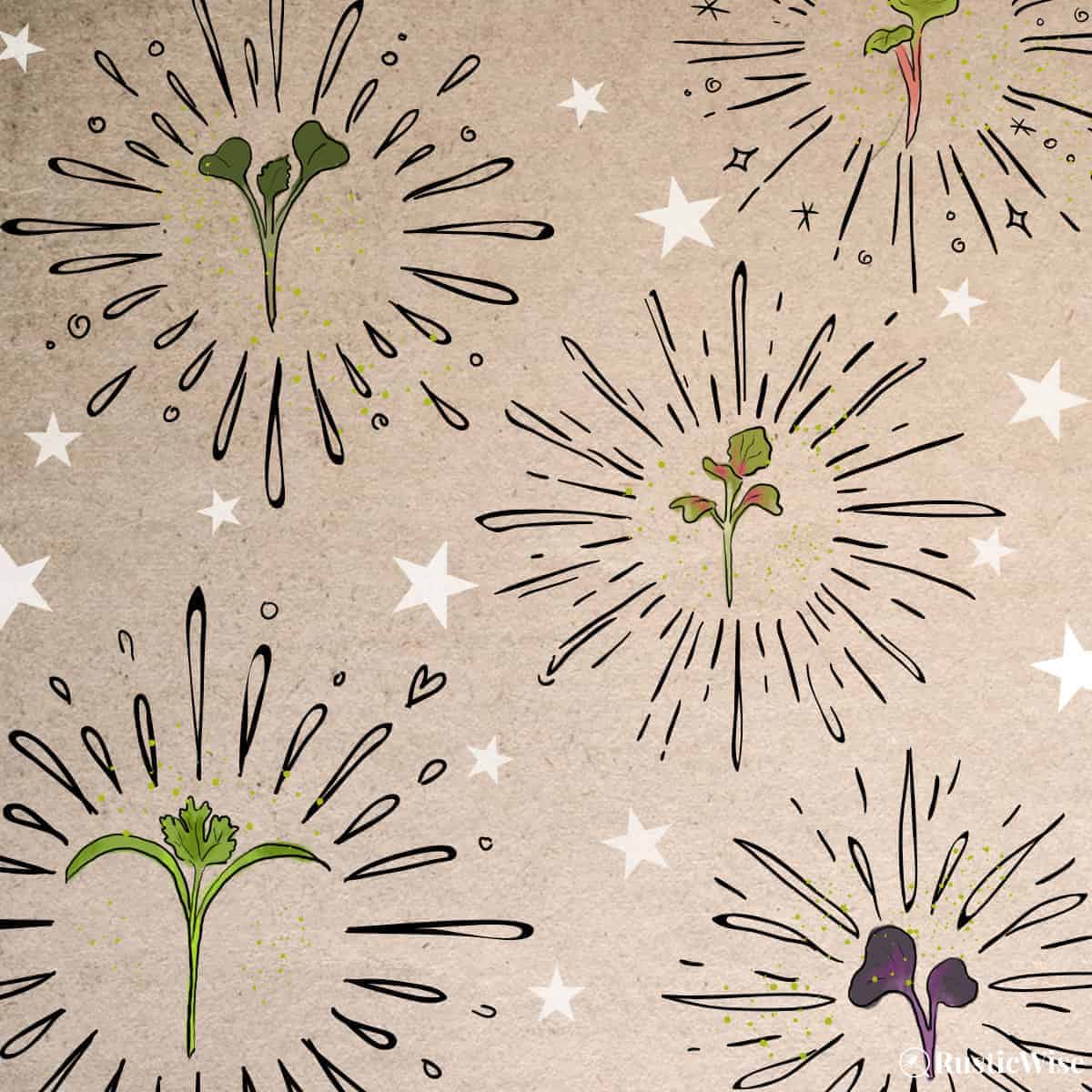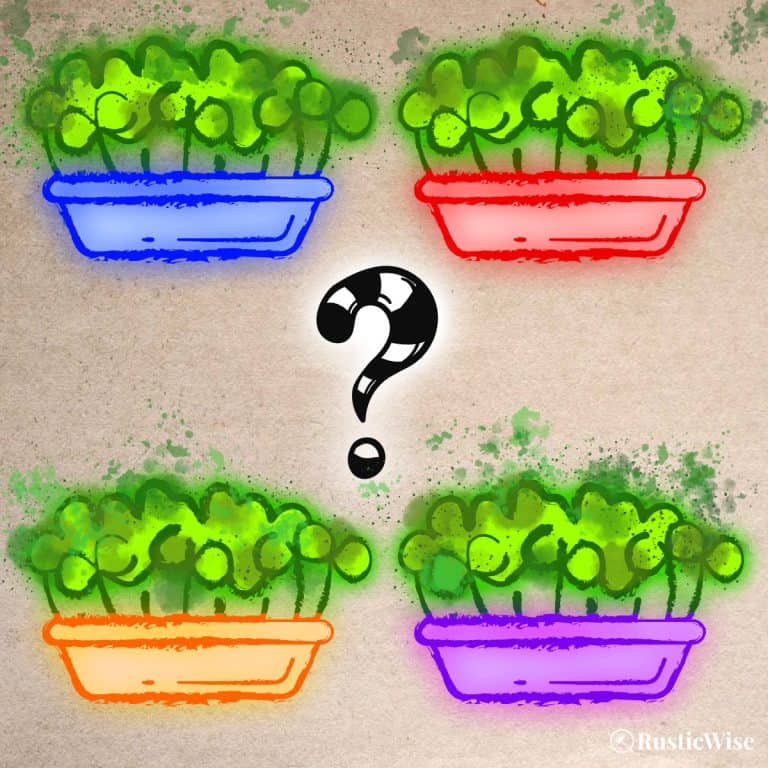12 Most Popular Microgreens To Grow
Popularity can be a fickle beast. “In” one day, and “out” the next, we would be wise to avoid chasing popularity. But in the world of microgreens, popular means best selling according to the masses. And if you’re looking for the best micros to grow for your own microgreens business, or simply for your family, this list is a solid place to start.
After all, if thousands of people prefer certain varieties of micros, there must be a good reason for it, right? Whether it’s because they’re easy to grow, have awesome health benefits, or simply taste great, here’s a roundup of the 12 most popular microgreens: arugula, beet, basil, broccoli, cabbage, cilantro, kale, custom blends/mixes, mustard, peas, radish, and sunflower.
Let’s take a closer look!
How I compiled this list of popular microgreens
I didn’t want to just list a few of the micros that I think are popular, I wanted to see what varieties are truly top sellers.
The Microgreens Market Report by Mordor Intelligence looks at growth, trends, and forecasts.¹ It lists five of the top players in the micros market that supply produce to restaurants and grocery stores (or specialty food stores). In no particular order, they are:
- Farmbox Greens (U.S.)
- AeroFarms (U.S.)
- Chef’s Garden (U.S.)
- Good Leaf Farms (Canada)
- Living Earth Farms (Canada)
I noted the varieties of microgreens each producer sold. Large producers obviously have to focus on growing varieties that have high demand, and that are cost and time effective (not to mention tasty!) for the masses. These greens are marketed to people who buy microgreens at the local grocery store.
To get a more representative look at those who prefer to grow their own micros, I looked at the top selling microgreens of two large microgreen seed suppliers: True Leaf Market and Johnny’s Seeds.
When a particular type of microgreen appeared across multiple suppliers’ top sellers list, it made the list below.
The following is a compilation of the 12 most popular microgreens (in alphabetical order).
12 Most popular microgreens you should try
Microgreens are simply the seedlings of plants harvested at an early stage of growth, so it makes sense that there are so many varieties.
The following varieties are the 12 most popular kinds of microgreens.
1. Arugula microgreens
Popular as part of a baby greens salad in its regular form, it turns out people also love the taste of arugula micros. With a peppery flavor, arugula adds a bit of spice with robust and nutty notes that prevent it from overpowering other flavors.
Great for salads, sandwiches, wraps, and homemade pesto, you can also throw a handful into a healthy smoothie. Packed with vitamins A, B, C, and E, along with a healthy dose of protein, calcium, and iron, arugula is a healthy addition to your diet.
Arugula seeds are mucilaginous which means they form a jelly-like sac around the seed when mixed with water. This makes them trickier to grow. However, the seeds germinate quickly, and the micros are ready to harvest in about 1 week.
2. Basil microgreens
If you love the sweet and spicy flavor of the mature herb, you’ll love the rich and powerful flavor packed in the tiny leaves and stems of basil microgreens. This highly sought-after herb is a smash hit for chefs in the restaurant industry, or for anyone looking to add an extra flavor dimension to homecooked meals.
Choose from a variety of seeds, including Genovese (aka sweet basil) and opal basil. It’s easy to use this type of microgreen—simply add it to any dish where you would normally use mature basil.
Basil micros pair well with Italian dishes, soups, pizza, and pesto. It’s a significant source of vitamin K, as well as omega-3s and omega 6-s.
Basil (like many other herb seeds) is a slower growing variety that requires some patience. It, too, has gelatinous seeds, so avoid overwatering to allow it to germinate and grow unhindered.
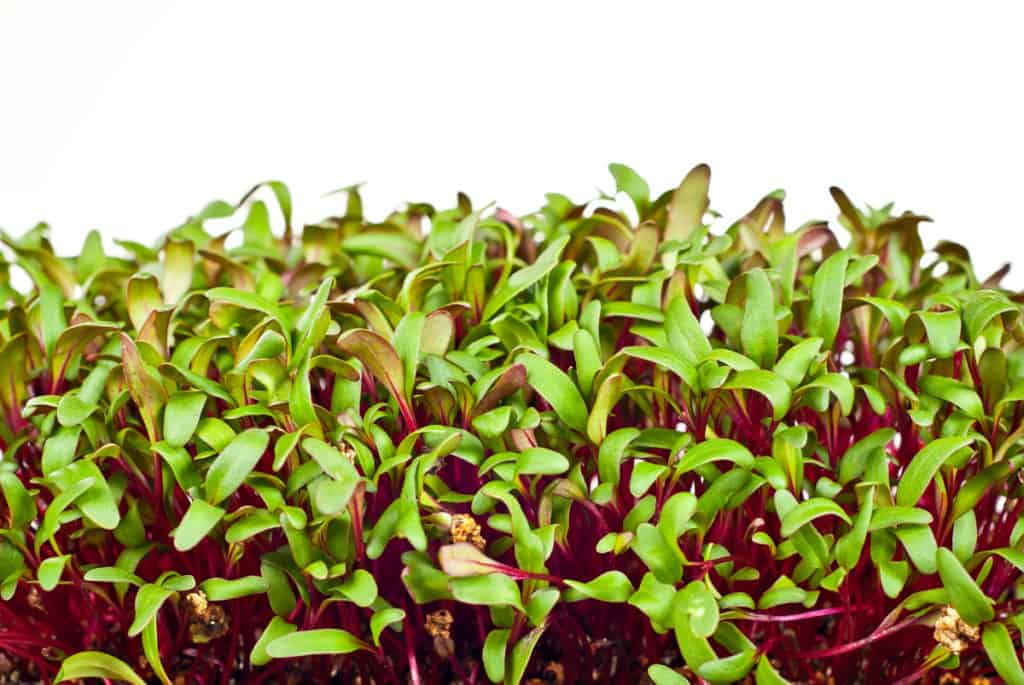
Credit: Deposit Photos
3. Beet microgreens
They have a versatile, sweet, and earthy flavor. And like the beetroot itself, it adds a vibrant splash of color. Tender beet microgreens brighten up salads, sandwiches, and wraps. They also make a wonderful garnish atop savory meat dishes, or roasted root veggies.
There are different beet seeds, including yellow varieties. But the red beet cultivars such as Bull’s Blood are very popular for their vivid color (pinkish stems and vibrant green leaves).
Beets contain exceptionally high levels of vitamin K. They also are an excellent source of vitamins A, C, and E, along with iron and calcium.
This a slower growing type of micro that has bumpy seeds that take better to soil (or soilless mediums) rather than grow mats.
4. Broccoli microgreens
This is a versatile and reliably tasty micro, so it’s no surprise that broccoli micros are one of the most popular microgreens. Their leafy green flavor is like the mature plant with a few spicy notes characteristic of many Brassicas, but milder and more delicate in taste.
One of the most nutrient-dense micros, broccoli microgreens contains a well-rounded assortment of vitamins, minerals, and has significant levels of plant-based protein. This Brassica also releases special compounds called sulforophanes when shredded in green smoothies or juices; these are potent anti-cancer agents.
Broccoli microgreens grow quickly and are ready to eat in less than 2 weeks. Watch out for tiny root hairs on broccoli seeds which are often confused for mold.
5. Cabbage microgreens
Another mild and agreeable tasting microgreen to make the list, cabbage micros contain high levels of vitamins A, C, and K.
There are many varieties of cabbage to choose from. Two of the most popular types are red cabbage and Chinese cabbage (also known as pak choi, bok choy, or pac choi).
While all types of cabbage are nutritious, red cabbage (sometimes called purple cabbage) is particularly healthy. Red cabbage contains greater amounts of vitamin C, carotenoids, and flavonoid antioxidants than their green counterparts. According to some research, red cabbage has 4.5 times the amount of antioxidants than green cabbage.²
This is a quick growing seed that is ready to enjoy between 5 and 14 days.
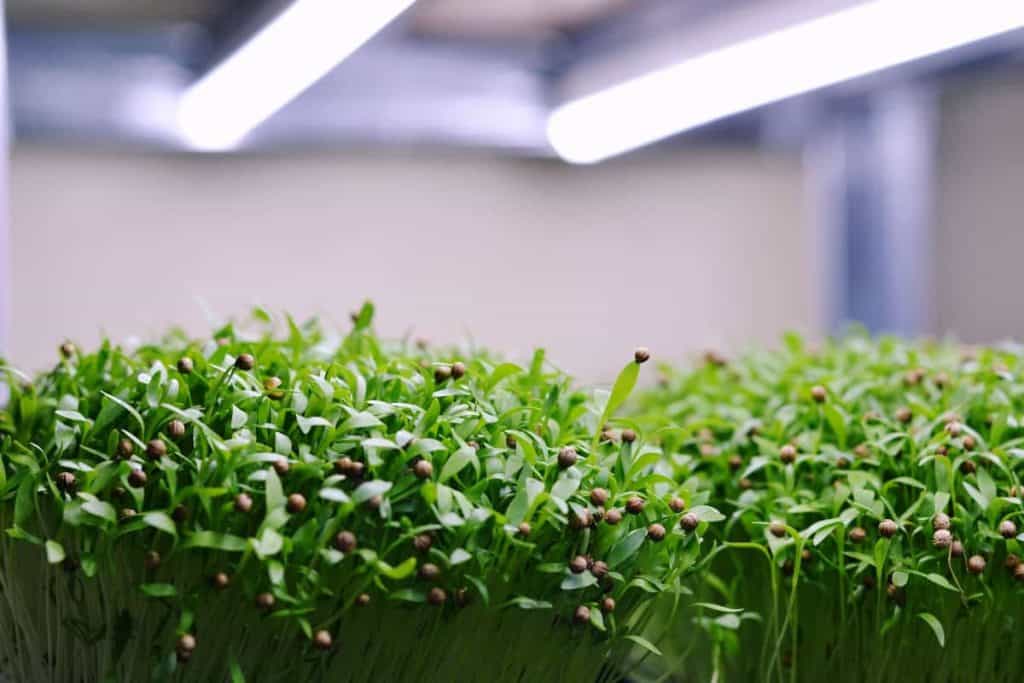
Credit: VectorState
6. Cilantro microgreens
I have to say that I’m a bit surprised that cilantro micros showed up across multiple top selling lists. Not that it isn’t tasty (it is), but because it’s slow growing and not the easiest micro to grow. I’m betting that it’s a top choice amongst chefs. But once you’ve tasted a bit of these tiny herbs, you’ll love the citrus notes and fragrant, sweet aroma.
Did you know that cilantro leaves come from the same plant (Coriandrum sativum) as coriander? Coriander is the spice made from the dried seeds.
This herb is slow to germinate, and can take up to 28 days before it’s ready to harvest. Cilantro micros grow best in soil (or soilless grow media) rather than mats.
7. Kale microgreens
A perennial favorite amongst many vegetable lovers, kale microgreens offer a similar sweet and mild flavor as its larger, mature counterparts.
Purple and red kale varieties are amongst the most popular microgreens as they have a vibrant splash of redish coloring on stems. Perfect for garnishing savory dishes, or adding to your sammie, wrap, or tossed salad.
Kale is also one of the best microgreens to grow for newbie gardeners. It germinates readily, and grows quickly.
8. Microgreen mixes
Why settle for one type of microgreen when you can enjoy a variety? Not surprising, a variety of micro mixes are best sellers across the board.
While each supplier has their own unique blend, many offer the following types of mixes:
- Spicy mixes: Often a mix of a few mild micros such as cabbage or kale, along with some mustard to kick things up.
- Salad mixes: A versatile blend of various veggies including arugula, broccoli, cabbage, kale, and kohlrabi.
- Radish mixes: A blend of spicy red/purple and green radishes.
- Rainbow mixes: A colorful mixture of greens and reds.
- Blends for various cuisines: Proprietary blends tailored toItalian, Asian, French, and Mediterranean cuisines.
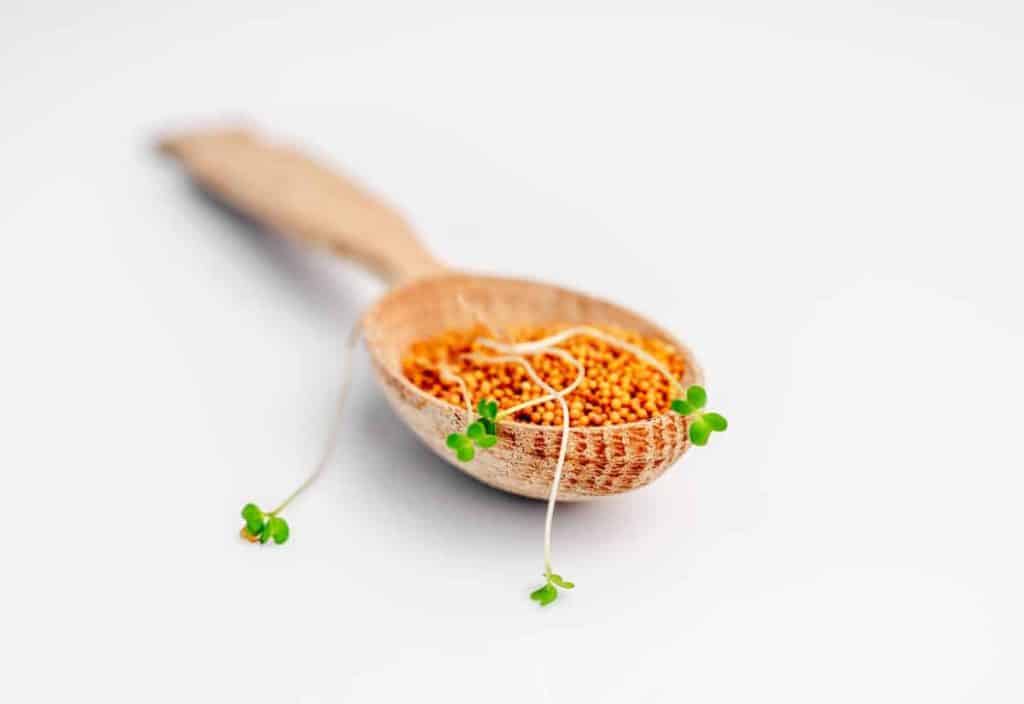
Credit: Yay Images
9. Mustard microgreens
It turns out, many people are looking for a spicy kick, and mustard microgreens offer just that! With an eye-popping flavor reminiscent of horseradish, it’s best to use sparingly in dishes. Or, blend with milder types of microgreens to tone down the fire.
Choose from red mustard, or Oriental mustard seeds (one of the spicier varieties to grow). Mustard greens are rich in vitamins A, B6, C, E, and K.
If you want to grow your own microgreens, mustard is a good choice. From sowing to harvest, it takes only 7 days.
10. Peas shoots
Pea microgreens have so many things going for them. They have a refreshing crunchy texture, with a sweet, spring-like flavor profile. Plus, the seeds are relatively inexpensive, and sometimes you can enjoy more than one harvest from your tray. They also grow larger than most other micros, offering plenty of bang-for-your-buck.
Their larger size makes them great as a salad base. They also can withstand a bit of heat, and work well in stir-fries. Pea shoots are packed with vitamin C, plus E, and B-vitamins. You’ll also benefit from fiber, protein, and omega-3s.
One growing tip is that you’ll need to soak the seeds first. Pre-sprouting them before sowing also helps kick-start the growing process. The tasty shoots are ready to harvest in 10–14 days.
11. Radish microgreens
Here’s another popular spicy microgreen to add to your list. With a sharp flavor with peppery notes like mature radish, radish micros liven up any dish.
A few popular cultivars to grow are daikon radish (a white-stemmed variety with pale green leaves) and Red Rambo (a purplish colored type).
If you’re looking for a boost in vitamin E, daikon radish can provide just that. A 2012 study found that daikon contains exceptionally high levels of vitamin E when compared to 24 other varieties of microgreens.³
Radish micros are easy and fast growing. They’re ready to harvest in 6–14 days, depending on the type.
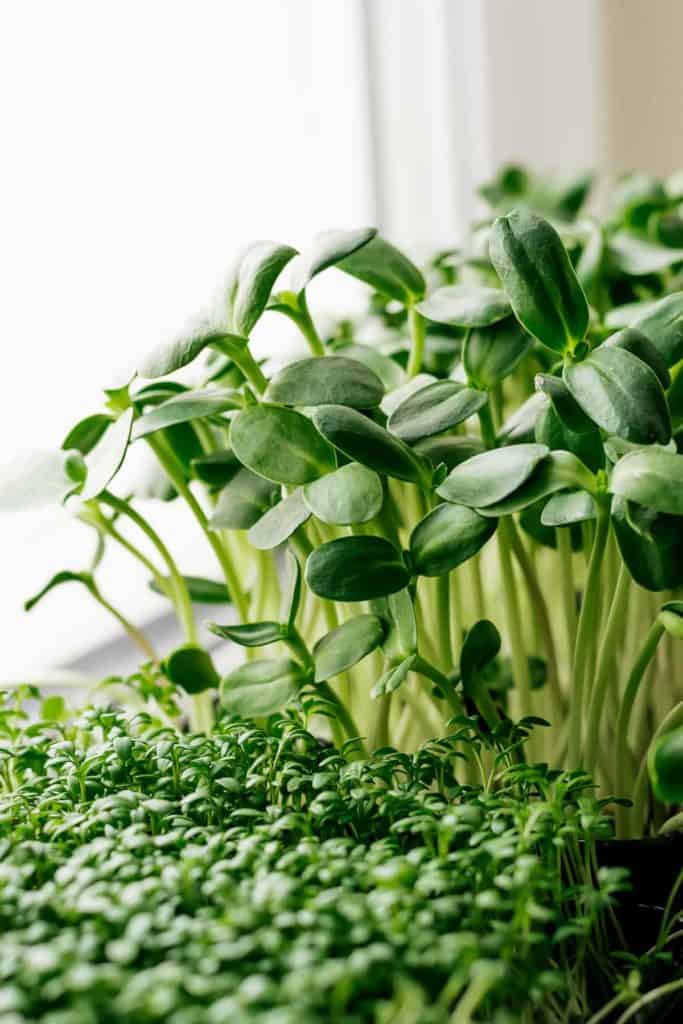
Credit: Deposit Photos
12. Sunflower microgreens
Sunflower shoots are a perennial favorite amongst many. It offers an earthy, nutty flavor that is a great addition to salads. The stems and leaves are quite large, making them a great pairing with pea shoots.
Rich in antioxidants, omega-3s and omega-6s, sunflower microgreens also contain all essential amino acids. Sunnies are also rich in iron and protein, which help with the generation of energy in your body.
Black oil sunflower seeds grow healthy and tasty shoots. Just like pea micros, the seeds require soaking and presprouting before sowing.
Why you should grow microgreens
Microgreens are easy-to-grow, nutrient-dense, and nutrient-rich greens for any meal. Chop them up and incorporate them into your favorite dishes, or eat them whole as a tasty and refreshing side dish.
No matter your taste, you’ll find that microgreens are amongst the easiest greens to grow. They can be grown in small spaces and are a healthy way to add a little more green to your everyday diet.
They’re also incredibly versatile and can be used in everything from salads to even pressed juices. It’s easy to start growing microgreens on your own and in your own home, too. You can get a grow light easily enough, or you can even use natural lighting.
No matter how you use them in, they’re sure to add a lot of flavor, color, and nutrition to your cooking!
Not all microgreens are easy to grow
Some microgreens are easier to grow than others. While some germinate easily and quickly, others require a bit of TLC.
A few of the easiest micros to grow are cabbage, radish, broccoli, and pea shoots.
👉Check out our in-depth look at the easiest microgreens to grow.
Using microgreens at home
Make like a chef and elevate your everyday dishes by adding a splash of nutritious microgreens to your dishes. It’s a great way to add an extra dimension of flavor, texture, and color.
Microgreens have a variety of uses in the kitchen:
- Use them as a garnish.
- Add them to salads, sandwiches, and wraps.
- Sprinkle them on top of pizza.
- Make pesto!
- Add during the last few minutes of cooking to sauces, soups, and stews.
- Add to healthy smoothies or green juices.
- Eat them as a tasty snack on its own.
No matter what flavor profile you are going for, microgreens will add dimension and nutrients to any dish.
Get started growing microgreens at home
Growing your own micros at home is a great way to enjoy the freshest greens without having to buy them at the grocery store. It also allows you to experiment with flavors, depending on the microgreen you plan to grow. Many types of vegetables, herbs, legumes, and grains are edible and offer a wide range of health benefits.
Treat them like you would any other seed. Maintain moderate moisture and keep the soil at room temperature. And you’ll be amazed at how quickly your microgreens grow.
It’s important to start by using quality seeds, preferably organic. Only use untreated seeds that are not treated with fungicides or pesticides. Getting better quality seeds offers higher germination rates, and a better, overall finished crop.
👉 If you like this post, see our Complete Guide to Growing Microgreens at Home. 🌱
Would you like more timeless tips via email?
Fun tips to help you live an independent, self-sustaining lifestyle. Opt-out at any time.


References
- Mordor Intelligence, Microgreens Market Report, https://www.mordorintelligence.com/industry-reports/microgreens-market. Accessed January 2023.
- Petre, Alina (10 December 2019). “8 Impressive Benefits of Purple Cabbage,” Healthline. Accessed January 2023.
- Lester, Gene & Xiao, Zhenlei & Luo, Yaguang & Wang, Qin. (2013). Microgreens: Assessment of Nutrient Concentrations. Journal of Agricultural and Food Chemistry. https://dx.doi.org/10.1021/jf300459b

Author: Theresa Tesolin
Theresa is co-founder of RusticWise. She helps people unleash their inner DIY spirit by encouraging them to get dirty and make or grow something from scratch.

